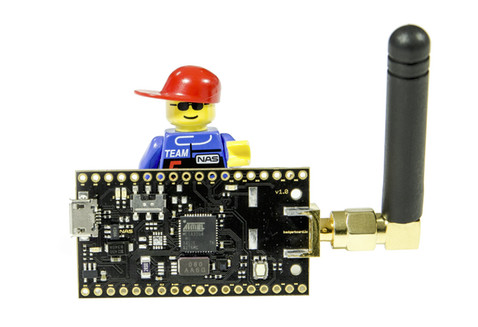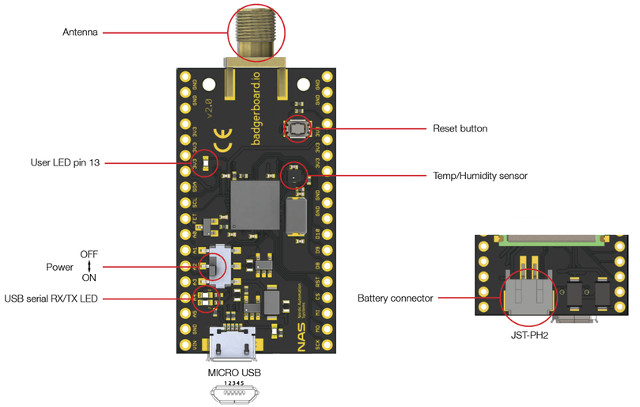Here comes one more LoRa board to play with. Badgerboard combines an Arduino compatible Atmel/Microchip AVR MCU with a Microchip RN2483 or RN2903 module in a breadboard compatible board powered via micro USB port or an external battery.
- MCU – Atmel ATmega32U4 MCU
- Connectivity – LoRaWAN via Microchip RN2483 (EU – 868MHz) / RN2903 (US – 915 MHz) modem with SMA connector and antenna
- USB – 1x micro USB port for power and programming
- Expansion – 2x 18-pin unpopulated headers with SPI, I2C, 13x GPIOs, 6x 10-bit ADC, 3.3V and GND signals; open drain output for relays up to 24V 100 mA
- Sensors – STM HTS221 temperature and humidity sensor
- Misc – Reset button; user and Tx/Rx LEDs; power on/off switch
- Power Supply – 5V via micro USB port, or Li-Ion/ Li-Po battery via JST connector
- Dimensions – 56 x 26 mm
The board can be programmed with the Arduino IDE and “tested and verified libraries for LoRaWAN communication”. You’ll find some code samples and libraries, pinout diagram and the board’s datasheet on Badgerboard.io website.
Nordic Automation Systems (NAS), the company behind the project, has experience with other wireless products based on Bluetooth Low Energy, ANT+, and IEEE 802.15.4 based protocols (6LoWPAN / ZigBee), and launched the project on Kickstarter aiming to raise 135,000 NOK (~$15,800) to fund mass production. Early bird rewards start at 365 NOK (~$43) and include the board, female and make pin headers, and an SMA antenna. Other rewards including multiple quantities of the basic kit, some kits with extra external sensors, up to Badgerboard Megapack for 5x boards with antennas, an outdoor gateway and 1-year NAS IoThub service for 12,270 NOK (~$1440 US). Shipping is included in the price, and delivery is scheduled for December 2016/January 2017 depending on the reward.

Jean-Luc started CNX Software in 2010 as a part-time endeavor, before quitting his job as a software engineering manager, and starting to write daily news, and reviews full time later in 2011.
Support CNX Software! Donate via cryptocurrencies, become a Patron on Patreon, or purchase goods on Amazon or Aliexpress






